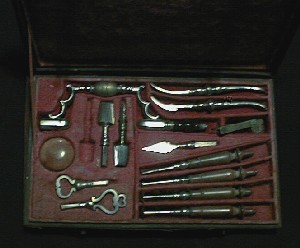A Hole in the Head
Today, we wonder why a man has a hole in his head. The University of Houston's College of Engineering presents this series about the machines that make our civilization run, and the people whose ingenuity created them.
For years I've been seeing something in books and museums that's troubled me. I've wanted to talk about it but haven't had the knowledge I needed. Now I know that knowledge doesn't exist.
Consider a case in point: It's a stone-age European skull -- a fine patrician head. There's a round hole in the top, three inches in diameter. The edges of the wound are healed over. The hole was cut carefully and intentionally, and the victim survived. This is very sophisticated surgery.
We find skulls like this all over the world. The hole in one from ancient Peru is just over the right ear -- an inch in diameter. An old skull from Judea has a square hole in the back.
The ancients were doing this surgery -- this trepanning of human skulls -- at least as long ago as 5000 years. They dared to cut into heads of living people -- people they knew. They did it without anesthetic. Yet they cannot tell us why they did such a thing. This was before they had writing; so we can only guess.
My 1970 encyclopaedia says flatly that ancients opened skulls to let out the evil spirits of disease. That tune changes in more recent articles. It's more likely that neolithic surgeons opened skulls to clean up local skull fractures and remove bone splinters. They used trepanning to relieve fluid pressure.
So: was this surgery the work of science or of superstition? When we try to answer, our 20th-century superstitions confuse us. Does lancing a boil release evil spirits or dead blood cells? If the result is the same, do we care? The useful question isn't, "What did stone age doctors believe about the process?" but "Did the process achieve healing?" Medicine is, after all, an empirical art. We judge what we do by success or failure.
Maybe some answers lie among modern primitive people. When Europeans came here, they found the Native Americans suturing wounds, setting bones, and doing amputations. They even opened the chest to drain abscesses. They knew how to use a bewildering array of herbal cures.
Two trepanned Aborigine skulls, only a few hundred yours old, recently turned up in Australia. Maybe all this cutting and sawing into flesh and bone was done to the songs of a spirit world. But I can't see how that either adds to, or takes from, its validity as empirical science.
In the end, we never will know why our stone-age ancestors trepanned human skulls -- not for sure. But I'll bet they did more good than harm with it. One thing we have to learn, over and over, is that our forbears were bright, inventive, risk-takers -- and that we have underrated them far too often.
I'm John Lienhard, at the University of Houston, where we're interested in the way inventive minds work.
(Theme music)
Lyons, A.S., and Petrucelli, R.J. II, Medicine: An Illustrated History. New York: Harry N. Abrams, Inc. Publisher, 1987.
In the following articles, we bear in mind that the verbs trephining and trepanning are near synonyms. (A modern trephine is a power driven circular saw. The older surgical trepan was a brace and bit that removed a circular bone plug.)
Webb, S.G., Two Possible Cases of Trephination from Australia. American Journal of Physical Anthropology, Vol. 75, 1988, pp. 541-548.
Prioreschi, P., Possible Reasons for Neolithic Skull Trephining. Perspectives in Biology and Medicine, Vol. 34, No. 2, Winter 1991, pp. 296-303. (see also a discussion of this article in Vol. 35, No. 2, 1992, pp. 311-313.)
A much earlier set of speculations on the purpose of trepanning is given in the five articles in the Sept. 1939 issue of Ciba Symposia, Vol. 1, No. 6.
Most early trepanning was done to males. Some 50 to 80 percent of the people trepanned lived to tell about it. A very small fraction of all ancient skulls have been trepanned. In a few cases we find skulls that have been trepanned several times.
I am grateful to Larry Wygant, University of Texas Medical Branch at Galveston, for advice and for the Ciba Symposium source.

photo by John Lienhard
An Eighteenth Century case of trephining tools from John Fulton's collection at Yale University